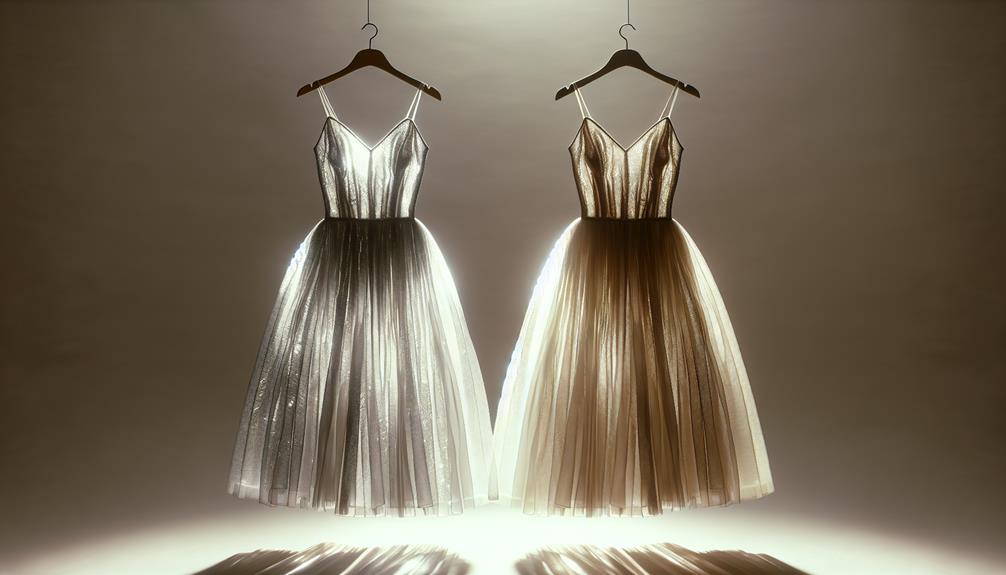I used to think that organza was always shiny, but I've learned it's not quite that simple. Sure, traditional silk organza has a lovely sheen because of its light-reflective silk threads and tight weaving. However, there are also matte organzas available now. These are made with different materials like cotton or synthetic fibers that don't reflect light the same way silk does. Plus, finishes can vary, from glossy calendering to pearlescent or even matte, altering the fabric's natural luster. So, while organza often catches the eye with its shimmer, it isn't a must-have trait. Stick around to uncover different organza styles and uses!
Table of Contents
Key Takeaways
- Organza is not always shiny; matte organza varieties offer a subdued aesthetic with less sheen.
- Silk organza has a more muted shine compared to synthetic versions, which are highly reflective.
- Cotton organza and polyester matte organza are specifically designed to reduce or eliminate glossiness.
- Finishing techniques like calendering enhance sheen, but options like embossing can focus on texture over shine.
- Organza can be treated with different coatings to achieve non-shiny finishes, broadening its use in fashion and decor.
What Is Organza?
Organza is a lightweight, sheer fabric traditionally made from silk, often used in fancy dresses and decorations. It's got this unique texture that's crisp and holds its shape well, which makes it perfect for creating volume and adding a sophisticated touch to outfits and event designs. You'll often see it in wedding gowns, prom dresses, and even in the layers of ballet tutus.
Here's a bit more about it: besides silk, organza can also be made from synthetic fibers like polyester or nylon. This shift in materials affects aspects like cost and care. Silk organza is more expensive and delicate, requiring careful handling, while synthetic versions are generally more durable and easier on the wallet.
It's important to know that organza's finish can vary. Some are super smooth and soft, while others might've a slightly stiffer feel. This variance largely depends on the type of fiber used and the manufacturing process involved. So, when you're choosing organza for any project, think about the final look and feel you're aiming for. This choice will directly influence the drape, texture, and overall aesthetic of your creation.
The Origin of Organza's Sheen
The sheen of organza comes primarily from the type of fibers used and how they're woven together. Traditionally, organza is made from silk, which is known for its natural luster. The threads of silk are smooth and light-reflective, contributing significantly to the shiny appearance of the fabric. When these silk threads are tightly twisted and then woven in a plain weave, the result is a crisp fabric with a characteristic shimmer.
But it's not just silk that can give organza its shine. Modern versions of organza might use synthetic fibers like polyester or nylon. These materials also have inherent shiny qualities and they mimic the light-reflecting properties of silk at a more affordable price point. The key is in how tightly these fibers are woven. The tighter the weave, the more pronounced the sheen.
I've found that the process of finishing the fabric also plays a role in enhancing its shine. After weaving, organza can undergo treatments that further increase its glossiness, making it even more appealing for those glamorous looks. So, while the base materials are crucial, the manufacturing techniques are just as important in bringing out that sought-after sparkle of organza.
Types of Organza Fabrics
When we talk about organza, it's important to know that there are different types out there.
You've got silk organza, which is the classic, shiny type most people think of, and then there are synthetic versions which can vary in how much they gleam.
There's also matte organza, which doesn't have that typical shine, showing that not all organza fabrics are created equal.
Silk Vs. Synthetic Organza
Understanding the differences between silk and synthetic organza can really impact your fabric choice for any project.
Silk organza is crafted from natural silk fibers, making it incredibly soft and with a subtle sheen that feels luxurious. It's also more breathable, which is a big plus for comfort.
On the flip side, synthetic organza, made from polyester or nylon, is much more affordable and offers greater durability. It's also resistant to shrinking and wrinkling, which is great for easier maintenance.
However, it doesn't breathe as well as silk, which can be a drawback in warm weather. Both types have their merits, so it really depends on what you're looking for in terms of cost, care, and wearability.
Matte Organza Varieties
Despite its typical sheen, organza also comes in matte varieties that offer a different aesthetic for various uses. Here's a quick rundown on a few matte organza types:
- Cotton Organza: This type blends cotton fibers with the traditional organza weave, reducing the sheen while maintaining a crisp texture. It's perfect for those who prefer a more understated elegance.
- Silk Crinkle Organza: While still maintaining a light sheen, this fabric features a crinkled surface that diffuses light differently, giving it a subtler glow compared to its glossy counterparts.
- Polyester Matte Organza: Made entirely from synthetic fibers, this version is more durable and offers a completely non-reflective finish, ideal for stage costumes and full-bodied skirts.
Organza Finishing Techniques
To enhance its appearance and texture, organza can undergo various finishing techniques. These methods are crucial if you're aiming for a specific look or feel in your fabric. One common technique is calendering. Here, I'm talking about passing the organza through heated rollers. This process gives the fabric a smoother and somewhat glossy finish, making it look really elegant. It's quite fascinating how heat can change the fabric's character!
Another technique I've explored is the application of different coatings. You can add a pearlescent finish to make the organza shimmer subtly, which is superb for evening wear. Or, for more practical uses, manufacturers might add a water-resistant coating. This makes the organza more durable and suitable for various applications, not just in fashion but also in decor.
Then there's embossing. This involves pressing patterns into the fabric under high pressure. It creates a textured effect that's not only visually appealing but also adds a unique tactile quality to the material. Whether it's floral designs or abstract motifs, embossing can really transform the basic organza into something extraordinary.
Through these techniques, the versatility of organza really shines through. It's not just about the shine; it's about crafting a fabric that fits the vision perfectly.
Comparing Silk and Synthetic Organza
Now let's compare silk and synthetic organza to see how each type holds up in terms of texture, durability, and appearance. When you're mastering the differences between these two, it's crucial to dive into the specifics:
- Texture
- Silk organza feels softer and more luxurious. It has a smooth, subtle sheen that's quite elegant. On the other hand, synthetic organza, often made from polyester, can feel stiffer and slightly coarse. This difference is mainly due to the natural fibers in silk versus the man-made fibers in synthetic versions.
- Durability
- Synthetic organza wins here. It's generally more durable and resistant to wear and tear compared to silk organza. Synthetic fibers are engineered to withstand more rigorous conditions, making them ideal for situations where your fabric might face tougher handling.
- Appearance
- Silk organza typically has a more muted shine, which can be seen as more sophisticated in certain styles. Synthetic organza, however, tends to have a higher sheen, which can be desirable for those looking for a glossier look but might feel less 'natural' depending on your aesthetic preferences.
Understanding these differences helps in choosing the right organza for your needs, ensuring you get the look, feel, and lifespan you're aiming for.
Uses of Non-Shiny Organza
Exploring the uses of non-shiny organza opens up a range of possibilities for both everyday and special occasion attire. When you think about non-shiny organza, it's not just about the lack of gloss; it's about the texture and subtlety it brings to garments. I find it perfect for creating more understated outfits. For example, it's ideal for making blouses that don't scream for attention but still carry an air of elegance.
I've also used non-shiny organza in layered skirts. The fabric adds volume without the added weight or sheen, making it comfortable and practical for long events. Plus, it's great for those who prefer a matte finish in their outfit. This type of organza maintains a soft, ethereal feel which is often sought in bridal wear and elegant evening gowns. It allows designers like me to play with silhouettes and layering without overpowering the overall look.
Moreover, non-shiny organza isn't just confined to clothing. I've incorporated it into various accessories, such as scarves and wraps, which add a subtle sophistication. Its versatility extends to home décor too, particularly in creating delicate curtain overlays that diffuse light softly, enhancing the ambiance of a room.
Frequently Asked Questions
How Do You Remove Wrinkles From Organza Fabric?
To smooth out organza, I gently steam it, keeping the iron a few inches away. I'll also hang it in the bathroom during a hot shower to let the steam naturally ease the wrinkles.
Is Organza Suitable for Outdoor Events?
I'd say organza's not the best for outdoor events. It's lightweight and can easily wrinkle or get damaged by weather. You might want to consider more durable fabrics for that purpose.
Can Organza Be Dyed at Home Easily?
I've found that you can dye organza at home, but it's tricky. You'll need acid dyes and careful heat control to avoid damaging the fabric. Always test on a small piece first!
What Are Common Mistakes When Sewing With Organza?
When I sew with organza, I've learned not to rush. Common mistakes include using the wrong needle, not finishing edges, and applying too much heat with the iron, which can lead to tears.
How Should Organza Garments Be Stored?
I hang my organza garments in a cool, dry closet to prevent wrinkles and damage. Using padded hangers helps maintain their shape without crushing the delicate fabric. It's all about careful handling.
- What Are the Pros and Cons of Organza Fabric? - April 23, 2024
- Is Organza Costly? - April 23, 2024
- How Many Types of Organza Are There? - April 23, 2024








